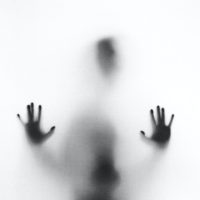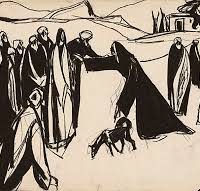Today is the Sunday of the Holy Trinity, the day we honor God Father, Son and Holy Spirit. And I would like to introduce you to a woman who saw this trinity reflected in all of creation: Hildegard of Bingen, who lived in the 12th century AD in what today is Germany and today mostly is known as a medieval mystic.
Hildegard was born into a family of landowning petty nobility. She was the tenth child, and as such, as was the custom in those days, dedicated to service in the church – she literally was tithed by her parents. At the age of eight, she was given into the care a widow who assumed her religious education. At the age of 14, she took her monastic vows.
Hildegard was a sickly child. Later in her life, she wrote that, from the tender age of three, she had divine visions, which came as she saw ‘an unbearable light’; she often fainted during such spells. Modern scientists guess that she might have suffered from extreme migraines. Hildegard would have these spells and visions throughout her life.
As a medieval woman, Hildegard received minimal formal education. She was mostly self-taught. Nevertheless, she excelled at many things: she was an accomplished healer who had extensive knowledge of the healing properties of herbs, barks, and berries. She composed numerous monophonic musical pieces – some of them were musical morality plays, precursors to the modern opera. She sought to understand the laws of nature and has been named the foremother of European natural sciences. She was interested in cosmology – how everything on earth and in heaven works together. She was a strong and effective abbess and leader, founding not one, but two convents on the banks of the Rhine River. She was so influential that she had the ear of emperors, bishops, and even the Pope, who sought her council. Which may be her most amazing feat, given the times she lived in. A woman – counseling the dignitaries of the day…
Hildegard was a Renaissance woman before there was such a thing. She was a genius.
She died at the ripe old age of 81. And even though she was never formally canonized, somehow she showed up on the saints’ calendar of the Roman Catholic Church and today usually is referred to as ‘Saint Hildegard’.
As I mentioned before, Hildegard received divine visions throughout her life. Many of them she dictated to a trusted monk, her secretary, who would write them down in Latin – again, Hildegard had very little formal education and needed such help. And these visions get pretty crazy; they are populated by fantastic heavenly creatures, and are fraught with symbolism. But those vision also disclose some very down-to-earth elements, informed by Hildegard’s studies of nature and the world.
And at the center of her visions and teachings is God, the Holy Trinity – Father – whom she prefers to call Godhead -, Son, and Holy Spirit.
Hildegard wasn’t the first one to acknowledge the mystical quality of the nature of a triune God – but she was the first one to express that this mystical quality is revealed in all of creation. For Hildegard, the Trinity represents the intricate and dynamic web of relationships and interconnectedness of all things.
She saw the Holy Trinity reflected in creation: humanity, animals and plants (she, like many before and after her, had an anthropocentric view of creation). Hildegard calls the Holy Spirit a ‘greening power’, which manifests itself especially in nature. She has become a patron saint of many environmentalists today, because she emphasizes the importance of a healthy balance in the trinity of all that God created.
Hildegard also understood our human nature as a trinity– we are body, emotion, and soul. She recognizes that, as human beings, we have physical, mental, and spiritual needs. Again, she stresses how these components need to be balanced in order for a person to be healthy and whole.
And she uses the example of a three legged stool. If one of these legs is nicked a little, the stool may wobble a little, but it’s still working. However, if there is major damage to even one of those legs, the whole thing is out of whack and won’t function anymore.
Thinking of the damage we have done to God’s creation, thinking of how many people feel unbalanced and ill today, she definitely is on to something…
God, three in one and one in three, models the perfect and intricate balance that make for wholeness and holiness. God models this amazing kind of dynamic stability, which leaves room for movement and growth as it assures us of God’s ever-present and everlasting love and care at the same time.
By the way, this image represents a vision Hildegard had about the Holy Trinity. It’s not a static triangle, as we so often see it depicted in art when it comes to the representation of the Holy Trinity, but is rather comprised of many circles, with Christ in the center. This whole vision suggests fluidity as it also represents wholeness and completeness.
It makes a lot of sense that this triune God imprints their image on all of creation, and all of us – that this is the way we were and all was created in the image of God.
It’s all about balance. It’s all about dynamic interaction and interconnectedness. These truly divine properties lead to life – life to the fullest for all creation. We only see too clearly how destruction and death take over when we deliberately or carelessly hack away at the three-legged stool of Trinitarian balance, when the web of intricate and dynamic interconnectedness is destroyed.
It’s all about relationships. And at the core of all relationships is the love of God, the Creator, the Redeemer, and the Spirit that breathes life into everyone and everything. So today, we don’t observe and celebrate an abstract divine concept that’s somehow way above our heads – we celebrate a triune God who is ‘love that cannot be without another’, as famous British writer C.S. Lewis says. We celebrate a God who is all about relationship, who models healthy and life-giving balance, and who, according to Hildegard of Bingen, calls us into the mysteries of all kinds of Trinitarian and as such divine relationships.
We celebrate a God who invites us to join in the everlasting dance of heaven and earth and everything beyond: one, two, three, one, two, three, one two three… Amen





